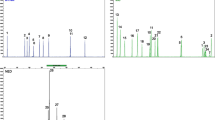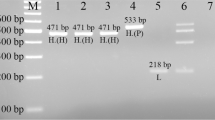Abstract
A multiplex PCR system was developed to identify the carnivore origins of faeces collected in Hokkaido, Japan, for epidemiological studies on Echinococcus multilocularis. Primers were designed against the D-loop region of mitochondrial DNA. Two separate primer mixtures (mix 1, specific forward primers to fox, raccoon dog and dog, and a universal reverse primer [prH]; and mix 2, specific forward primers to cat, raccoon and weasels and prH) were used so that the PCR products (160 bp, fox and cat; 240 bp, raccoon dog and raccoon; and 330 bp, dog and weasel) were distinguished by size. The multiplex PCR exhibited no cross-reactivity between carnivore species and did not amplify DNA from rodent prey. When 270 field-collected faeces were examined, 250 showed single PCR products belonging to specific target sizes, suggesting successful carnivore identification for 92.6% of samples. Taeniid eggs were detected in 11.1% of samples and coproantigen in 30.4%; whereas the prevalences of taeniid eggs and coproantigen were 12.9% and 34.0% in fox faeces, and 0% and 26.3% in cat faeces, respectively. These results suggest that the prevalence in different target animals can be evaluated individually and precisely using multiplex PCR system.

Similar content being viewed by others
References
Al-Sabi’ MNS, Kapel CMO, Deplazes P, Mathis A (2007) Comparative copro-diagnosis of Echinococcus multilocularis in experimentally infected foxes. Parasitol Res 101:731–736
Dalen L, Götherström A, Angerbjörn A (2004) Identifying species from pieces of faeces. Conserv Genet 5:109–111
Davison A, Birks JDS, Brookes RC, Braithwaite TC, Messenger E (2002) On the origin of faeces: morphological versus molecular methods for surveying rare carnivores from their scats. J Zool 257:141–143
Deuter R, Pietsch S, Hertel S, Müler O (1995) A method for preparation of fecal DNA suitable for PCR. Nucleic Acids Res 23:3800–3801
Eckert J, Deplazes P, Craig PS, Gemmell MA, Gottstein B, Health D, Jenkins DJ, Kamiya M, Lightowlers M (2001) Echinococcosis in animals: clinical aspects, diagnosis and treatment. In: Eckert J, Gemmell MA, Meslin F-X, Pawlowski ZS (eds) WHO/OIE Manual on Echinococcosis in Humans and Animals: a Public Health Problem of Global Concern. Office International des Epizooties, Paris, pp 72–99
Flagstad Ø, Røed K, Stacy JE, Jakobsen KS (1999) Reliable noninvasive genotyping based on excremental PCR of nuclear DNA purified with a magnetic bead protocol. Mol Ecol 8:879–883
Foran DR, Crooks KR, Minta SC (1997) Species identification from scat: an unambiguous genetic method. Wildlife Soc Bull 25:835–839
Frantz AC, Pope LC, Carpenter PJ, Roper TJ, Wilson GJ, Delahay RJ, Burke T (2003) Reliable microsatellite genotyping of the Eurasian badger (Meles meles) using faecal DNA. Mol Ecol 12:1649–1661
Frantzen MAJ, Silk JB, Ferguson JWH, Wayne RK, Kohn MH (1998) Empirical evaluation of preservation methods for faecal DNA. Mol Ecol 7:1423–1428
Fraser A, Craig PS (1997) Detection of gastrointestinal helminth infections using coproantigen and molecular diagnostic approaches. J Helminthol 71:103–107
Gerloff U, Hartung B, Fruth B, Hohmann G, Tautz D (1999) Intracommunity relationships, dispersal pattern and paternity success in a wild living community of bonobos (Pan paniscus) determined from DNA analysis of faecal samples. Proc Royal Soc London, Series B Biol Sci 266:1189–1195
Hegglin D, Ward PI, Deplazes P (2003) Anthelmintic baiting of foxes against urban contamination with Echinococcus multilocularis. Emerg Inf Dis 9:1266–1272
Huber S, Bruns U, Arnold W (2003) Genotyping herbivore feces facilitating their further analyses. Wildlife Soc Bull 31:692–697
Inoue T, Nonaka N, Mizuno A, Morishima Y, Sato H, Katakura K, Oku Y (2007) Mitochondrial DNA phylogeography of the red fox (Vulpes vuples) in northern Japan. Zool Sci 24:1178–1186
Kohn MH, Wayne RK (1997) Facts from feces revisited. Trends Ecol Evol 12:223–227
Kovach AI, Litvaitis MK, Litvaitis JA (2003) Evaluation of fecal mtDNA analysis as a method to determine the geographic distribution of a rare lagomorph. Wildlife Soc Bull 31:1061–1065
Malgor R, Nonaka N, Basmadjian I, Sakai H, Carambula B, Oku Y, Carmona C, Kamiya M (1997) Coproantigen detection in dogs experimentally and naturally infected with Echinococcus granulosus by a monoclonal antibody-based enzyme-linked immunosorbent assay. Int J Parasitol 27:1605–1612
Mathis A, Deplazes P, Eckert J (1996) Improved test system for PCR-based specific detection of Echinococcus multilocularis eggs. J Helminthol 70:219–222
Monteiro L, Bonnemaison D, Vekris A, Petry KG, Bonnet J, Vidal R, Cabrita J, Mégraud F (1997) Complex polysaccharides as PCR inhibitors in feces: Helicobacter pylori model. J Clin Microbiol 35:995–998
Morishima Y, Tsukada H, Nonaka N, Oku Y, Kamiya M (1999) Coproantigen survey for Echinococcus multilocularis prevalence of red foxes in Hokkaido, Japan. Parasitol Int 48:121–134
Murphy MA, Waits LP, Kendall KC (2000) Quantitative evaluation of fecal drying methods for brown bear DNA analysis. Wildlife Soc Bull 28:951–957
Murphy MA, Waits LP, Kendall KC, Wasser SK, Higbee JA, Bogden R (2002) An evaluation of long-term preservation methods for brown bear (Ursus arctos) faecal DNA samples. Conserv Genet 3:435–440
Nonaka N, Tsukada H, Abe N, Oku Y, Kamiya M (1998) Monitoring of Echinococcus multilocularis infection in red foxes in Shiretoko, Japan, by coproantigen detection. Parasitology 117:193–200
Palomares F, Godoy JA, Piriz A, O’Brien SJ, Johnson WE (2002) Faecal genetic analysis to determine the presence and distribution of elusive carnivores: design and feasibility for the Iberian lynx. Mol Ecol 11:2171–2182
Paxinos E, Mcintosh C, Ralls K, Fleischer R (1997) A noninvasive method for distinguishing among canid species: amplification and enzyme restriction of DNA from dung. Mol Ecol 6:483–486
Piggot MP, Taylor AC (2003) Extensive evaluation of faecal preservation and DNA extraction methods in Australian native and introduced species. Aust J Zool 51:341–355
Pires AE, Fernandes ML (2003) Last lynxes in Portugal? Molecular approaches in a pre-extinction scenario. Conserv Genet 4:525–532
R Development Core Team (2008) R: A language and environment for statistical computing. R Foundation for Statistical Computing, Vienna, Austria. ISBN 3-900051-07-0, URL http://www.R-project.org
Raoul F, Deplazes P, Nonaka N, Piarroux R, Vuitton DA, Giraudoux P (2001) Assessment of the epidemiological status of Echinococcus multilocularis in foxes in France using ELISA coprotests on fox feces collected in the field. Int J Parasitol 31:1579–1588
Sakashita M, Sakai H, Kohno H, Ooi H-K, Oku Y, Yagi K, Ito M, Kamiya M (1995) Detection of Echinococcus multilocularis coproantigens in experimentally infected dogs using murine monoclonal antibody against adult worms. Jpn J Parasitol 44:413–420
Tsukada H, Morishima Y, Nonaka N, Oku Y, Kamiya M (2000) Preliminary study of the role of red foxes in Echinococcus multilocularis transmission in the urban area of Sapporo, Japan. Parasitology 120:423–428
Tsukada H, Hamazaki K, Ganzorig S, Iwaki T, Konno K, Lagapa JT, Matsuo K, Ono A, Shimizu M, Sakai H, Morishima Y, Nonaka N, Oku Y, Kamiya M (2002) Potential remedy against Echinococcus multilocularis in wild red foxes using baits with anthelmintic distributed around fox breeding dens in Hokkaido, Japan. Parasitology 125:119–129
Verma SK, Prasad K, Nagesh N, Sultana M, Singh L (2003) Was elusive carnivore a panther? DNA typing of faeces reveals the mystery. Forensic Sci Int 137:16–20
Wasser SK, Houston CS, Koehler GM, Cadd GG, Fain SR (1997) Techniques for application of faecal DNA methods to field studies of Ursids. Mol Ecol 6:1091–1097
Yamauchi K, Hamasaki S, Miyazaki K, Kikusui T, Takeuchi Y, Mori Y (2000) Sex determination based on fecal DNA analysis of the amelogenin gene in Sika deer (Cervus nippon). J Vet Med Sci 62:669–671
Yimam AW, Nonaka N, Oku Y, Kamiya M (2002) Prevalence and intensity of Echinococcus multilocularis in red foxes (Vulpes vulpes schrencki) and raccoon dogs (Nyctereutes procyonoides albus) in Otaru city, Hokkaido, Japan. Jpn J Vet Res 49:287–296
Acknowledgements
The authors acknowledge Dr. Hitoshi Suzuki in Graduate School of Environmental Earth Science, Hokkaido University, for providing DNA materials from rodents in the field. We would like to thank Drs. Bruno Gottstein (University of Bern), Peter Deplazes (University of Zurich), Alexander Mathis (University of Zurich), Francis Raoul (University of Franche-Comte) and Jean M. Bart (Hospital Minjoz, France) for supplying us parasite samples. We are also grateful to Dr. Guo Zhihong in University of Miyazaki, and the members of the Laboratory of Parasitology, Graduate School of Veterinary Medicine, Hokkaido University, for their valuable support. This work was supported by the Japan Society for the promotion of Science (grant no. 15380205) and by the Ministry of Health, Labour and Welfare, Japan (grant for "The control of emerging and reemerging diseases in Japan").
Author information
Authors and Affiliations
Corresponding author
Rights and permissions
About this article
Cite this article
Nonaka, N., Sano, T., Inoue, T. et al. Multiplex PCR system for identifying the carnivore origins of faeces for an epidemiological study on Echinococcus multilocularis in Hokkaido, Japan. Parasitol Res 106, 75–83 (2009). https://doi.org/10.1007/s00436-009-1629-0
Received:
Accepted:
Published:
Issue Date:
DOI: https://doi.org/10.1007/s00436-009-1629-0




